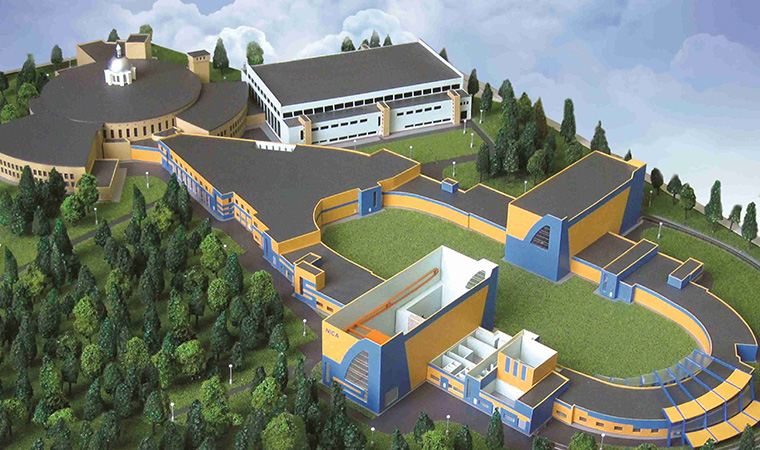
Universe in the lab
back to contentsNICA will take a rightful place in the ranks of the most powerful particle accelerators capable of recreating processes that existed in the Universe immediately after its birth. The most well known of them, Large Hadron Collider in CERN, collides particles with very high energies of several teraelectronvolts in a 27-kilometer ring-shaped tunnel. LHC is set to find an elusive Higgs boson, a particle said to give mass to other particles. The role of NICA is somewhat different, this is why its circular tunnel and collision energy will be much less (503 meters and several gigaelectronvolts respectively). NICA will study how quarks and gluons formed baryonic matter, a constituent of our visible universe. By colliding heavy ions of gold, researches will try to recreate the first moments of the universe evolution, just microseconds after the Big Bang.
The project involves 24 countries, and Rosatom, Russia’s state-run nuclear corporation and a long-standing partner of JINR, could not miss the opportunity to join. One of the problems faced during the project design phase was the necessity to reestablish production of Radio Frequency Quadrupole (RFQ) linear accelerators. Developed in the USSR, they were a breakthrough at that time. At present, RFQ accelerators are in operation in many countries of the world, but Russia has built none for the last 30 years. In cooperation with the Russian Academy of Sciences and JINR laboratory of high energy physics, Zababakhin Russian Research Institute of Technical Physics (a subsidiary of Rosatom) has developed a new RFQ accelerator for the collider’s injection facility.
Bochvar Russian Research Institute of Inorganic Materials (a subsidiary of Rosatom’s TVEL Fuel Company) has designed a production technology for superconducting strands to be used in the collider’s magnet system. “Powerful superconducting magnets are needed to accelerate charged ions and collide them at extremely high energies. It is only them that can generate magnetic fields of required intensity and ensure the needed energy density and collision energy,” explains Ildar Abdyukhanov, Deputy Director of Bochvar Institute. “We have developed several superconductor designs and production technologies, all fully compliant with customer specifications. The superconductors are manufactured at the Chepetsk Mechanical Plant under the supervision of Bochvar Institute. We will also study behavior of our superconductors in different magnetic fields.”
Rosatom benefits from doing the engineering part of this international scientific project. Collider-based experiments are a global issue that will be discussed by academia all over the world, mentioning Russia’s contribution to the project, Ildar Abdyukhanov assures. This is far from the only benefit of project participation.
Apart from fundamental studies, NICA will be also engaged in applied research for the nuclear industry. “Accelerated heavy ions can be used to treat cancerous diseases, irradiate electronic devices and study their resistance to radioactive exposure. Transmutation of spent nuclear fuel and radioactive waste can be studied, too,” JINR Vice-Director Grigory Trubnikov adds. “Rosatom is our strategic partner, and we will soon sign an agreement on its equal participation in NICA.”
It should be noted that the accelerator in JINR will become a test ground for would-be nuclear professionals as every year up to 20 students of the National Nuclear Research University (MEPhI) do internship and defend their graduation theses at JINR. As the NICA project develops, increasingly more students will take part in collider-based experiments to obtain unique knowledge and expertise.
Another joint project, this time between JINR, Rosatom and the Institute of Theoretical and Experimental Physics, has been launched at Kalinin NPP where a DANSS neutrino detector was installed to conduct fundamental studies (search for sterile neutrinos whose existence is not proved yet). It will also be used as a diagnostic tool for the reactor core as it is capable of remotely measuring thermal power and fuel composition. These parameters help identify areas with maximum heat output, assess fuel burnup and monitor conditions in the reactor core in emergencies.




